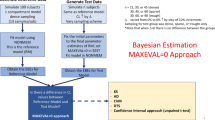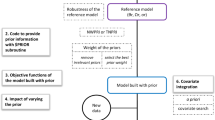Abstract
Individual pharmacokinetic parameters quantify the pharmacokinetics of an individual, while population pharmacokinetic parameters quantify population mean kinetics, interindividual variability, and residual intraindividual variability plus measurement error. Individual pharmacokinetics are estimated by fitting individual data to a pharmacokinetic model. Population pharmacokinetic parameters are estimated either by fitting all individual's data together as though there were no individual kinetic differences (the naive pooled data approach), or by fitting each individual's data separately, and then combining the individual parameter estimates (the two-stage approach). A third approach, NONMEM, takes a middle course between these, and avoids shortcomings of each of them. A data set consisting of 124 steady-state phenytoin concentration-dosage pairs from 49 patients, obtained in the routine course of their therapy, was analyzed by each method. The resulting population parameter estimates differ considerably (population mean Km, for example, is estimated as 1.57, 5.36, and 4.44 μg/ml by the naive pooled data, two-stage, and NONMEM approaches, respectively). Simulations of the data were analyzed to investigate these differences. The simulations indicate that the pooled data approach fails to estimate variabilities and produces imprecise estimates of mean kinetics. The two-stage appproach produces good estimates of mean kinetics, but biased and imprecise estimates of interindividual variability. NONMEM produces accurate and precise estimates of all parameters, and also reasonable confidence intervals for them. This performance is exactly what is expected from theoretical considerations and provides empirical support for the use of NONMEM when estimating population pharmacokinetics from routine type patient data.
Similar content being viewed by others
References
T. M. Ludden, J. P. Allen, W. A. Valutzky, A. V. Vicuna, J. M. Nappi, S. F. Hoffman, J. E. Wallace, P. Lalka, and J. L. McNay. Individualization of phenytoin dosage regimes.Clin. Pharmacol. Ther. 21:287–295 (1977).
C. M. Metzler, G. L. Elfring, and A. J. McEwen.A Users Manual for Nonlin and Associated Programs, Upjohn Co., Kalamazoo, Mich. 1974.
W. J. Dixon and F. J. Massey.Introduction to Statistical Analysis, McGraw-Hill, New York, 1969, pp. 101–104.
L. B. Sheiner, B. Rosenberg, and K. L. Melmon. Modelling of individual pharmacokinetics for computer-aided drug dosage.Comp. Biomed. Res. 5:441–459 (1972).
L. B. Sheiner, B. Rosenberg, and V. V. Marathe. Estimation of population characteristics of pharmacokinetic parameters from routine clinical data.J. Pharmacokin. Biopharm. 5:445–479 (1977).
S. L. Beal. Adaptive M estimation with independent not identically distributed data. Ph.D. dissertation, Univ. of California, Los Angeles, 1974.
S. L. Beal and L. B. Sheiner.NONMEM Users Guide—Part 1, Users Basic Guide, Division of Clinical Pharmacology, University of California, San Francisco, 1979.
S. Vozeh, A. Koelz, E. Martin, H. Magin, G. Scollo-Lovizzari, and F. Follath. Predictability of phenytoin serum levels by nomograms and clinicians.Eur. Neurol., in press.
A. Richens. A study of the pharmacokinetics of phenytoin (diphenyl-hydantoin) in epileptic patients, and the development of a nomogram for making dose increments.Epilepsia 16:627–646 (1975).
A. Richens and A. Dunlop. Serum phenytoin levels in management of epilepsy.Lancet II:247–248 (1975).
L. Lund and G. Alvan. Phenytoin dosage nomogram (letter).Lancet II:1305 (1975).
J. Gordo, J. Schaublin, and P. Spring. Microdetermination of plasma diphenylhydantoin by gas-liquid chromatography.J. Chromatogr. 143:171–181 (1977).
G. Box and M. Muller. A note on the generation of random normal deviates.Ann. Math. Statist. 29:610–611 (1958).
P. Lewis, A. Goodman, and J. Miller. A pseudo random number generator for the system 360.IBM Systems J. 8:136–146 (1969).
W. T. Dixon and F. J. Massey.Introduction to Statistical Analysis, McGraw-Hill, New York, 1969, p. 501.
L. B. Sheiner, S. Beal, B. Rosenberg, and V. V. Marathe. Forecasting individual pharmacokinetics.Clin. Pharmacol Ther. 26:294–305 (1979).
J. H. Matis and H. D. Tolley. On the stochastic modeling of tracer kinetics.Fed. Proc. 39:104–109 (1980).
Author information
Authors and Affiliations
Additional information
Work supported in part by NIH Grants GM 26676 and GM 26691.
Rights and permissions
About this article
Cite this article
Sheiner, L.B., Beal, S.L. Evaluation of methods for estimating population pharmacokinetic parameters. I. Michaelis-menten model: Routine clinical pharmacokinetic data. Journal of Pharmacokinetics and Biopharmaceutics 8, 553–571 (1980). https://doi.org/10.1007/BF01060053
Received:
Revised:
Published:
Issue Date:
DOI: https://doi.org/10.1007/BF01060053




